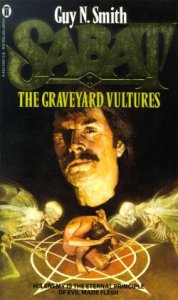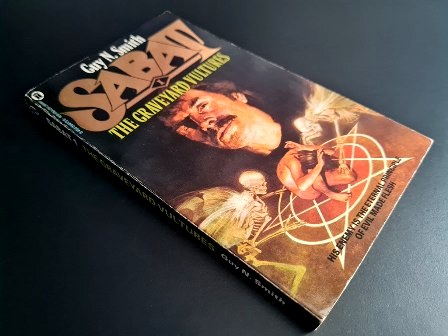
First published back in May of 1982; already somewhat of a pulp horror veteran, prolific author Guy N Smith released the first of the four part ‘Sabat’ series entitled ‘Sabat 1: The Graveyard Vultures’.
DLS Synopsis:
Mark Sabat is an ex-priest (he left religion after doubting his own faith brought about by the hypocrisy of church leaders), later to be trained by the SAS to become a finely tuned killer, who is now working as a freelance exorcist. Sabat’s powers transcend those of the flesh. He is able to leave his body, allowing his astral self to not only travel across land, but also to move within the spiritual world.
Now, Sabat finally has the chance to confront his nemesis. An enemy that is thought to be the epitome of evil made flesh. This being is none other than his brother - Quentin Sabat. However, when their conflict sways in favour of Quentin, Sabat takes the decision to destroy his rival’s physical form with the use of his .38 revolver. In doing so, as Quentin’s body dies, so his astral self becomes trapped inside that of Mark Sabat. Now Sabat must live with the consequences of having his evil brother locked inside his own mind.
A number of years later and Sabat is requested to perform an exorcism at St Adrian’s Church following the exhumation and desecration of a number of corpses from within its cemetery grounds. When a local girl’s corpse is found brutally trampled to death by cloven hoofs, satanic rituals are believed to have been at the route of this despicable spat in sacrilegious and murderous crime.
Upon arriving at the usually quiet country village, Sabat spots an attractive woman by the name of Miranda drinking in the ‘Dun Cow’ pub where he is staying. That night, Sabat projects his astral self out to Miranda’s abode where he witnesses a conversation (amongst other things) with the young whore and a man who declares himself to be a dark priest of the Left Hand Path.
The man, known as Royston, has already exhumed the skeletal remains of one of the most evil satanic priests to have ever lived – that of William Gardiner. With the dead priest’s remains now in his possession, Royston plans to resurrect this dark master of evil into his own body.
Having already been warned off the case by the local Detective Inspector Plowden, as well as the Bishop Wentnor, Sabat realises he must work alone in trying to bring an end to this corrupting evil.
As equally evil as he is good, Sabat is put up against some of the most powerful forces of darkness, where he must choose which side to make allies with, choose who to trust, and ultimately who to deceive. Sabat’s powers will be put to the test time and time again. His inner fight against his evil brother, yet another factor to contend with. The satanic powers of darkness are ready for him...
DLS Review:
From the beginning prologue, Smith thrusts the reader into the throngs of Sabat’s battle against his evil brother Quentin. This occult-heavy conflict throws down a litany of eye-opening spiritual powers for the reader to get to grips with; paving the way for the setup of the whole series. The strange reverse Cain and Abel story forms the basis for the complex and utterly original character of Mark Sabat. In making the principal protagonist a split between pure evil and a gritty, principal-driven exorcist with a grudge to bear; Smith has created the ultimate in anti-heroes. In doing this, the inspired character of Mark Sabat quickly becomes the very backbone of the tales, even from within this first novel. Sabat lacks any real degree of sympathy. He acts on a different moral plane than you and I. He’s a self-tortured, sexually charged killer with more knowledge and skill at the dark arts than anyone else.
Not before long, Smith throws in a pretty daring scene of rape (of which Sabat is the perpetrator), challengingly the very core principals behind our lead protagonist of Mark Sabat. Although the whole premise is skirted around with some rather risqué ideas of deep-seated enjoyment and possibly even that the rape was part of the whore’s comeuppance, the justification still leaves a slightly wrongful taste in the readers mouth. This no-holds-barred approach to delivering such impactful passages of pure pulpy exploitation are what makes Smith really stand out from the pack. And I for one wouldn’t change his style for the world.
So, from some quite questionable moments of justification, Smith carries on with painting an elaborate picture of this complex principal character. His spiritual abilities and the rituals involved are detailed and defined relatively early on as part of the unfolding story.
The pace is fast and furious throughout. When Sabat isn’t challenging authority in some way, or fulfilling his raging (and insatiable) sexual desires, or fighting an inner-battle against his evil brother, he’s out fighting the powers of evil with guns and crucifixes and pacts with various dark gods from the spiritual world.
This is occultist pulp horror set on overdrive. Smith throws in a veritable abundance of occultist gods and other such notions of spiritual ideology. Although Smith’s inclusion of such aspects take on a vital part in the unfolding storyline, he never lets the tale get too bogged down in this. Instead, the novel races on with smatterings of occultist ideology and action-packed scenes of mind-boggling exorcisms.
This really is a master class in occultist pulp horror fiction. The pace, the characterisation, the various subplots and intrinsic levels to the storyline, all make this a truly fantastic piece of entertaining horror fiction. Not to mention the copious levels of bloodspill and sadistic violence.
The novel runs for a total of 160 pages.

DLS Synopsis:
Mark Sabat is an ex-priest (he left religion after doubting his own faith brought about by the hypocrisy of church leaders), later to be trained by the SAS to become a finely tuned killer, who is now working as a freelance exorcist. Sabat’s powers transcend those of the flesh. He is able to leave his body, allowing his astral self to not only travel across land, but also to move within the spiritual world.
Now, Sabat finally has the chance to confront his nemesis. An enemy that is thought to be the epitome of evil made flesh. This being is none other than his brother - Quentin Sabat. However, when their conflict sways in favour of Quentin, Sabat takes the decision to destroy his rival’s physical form with the use of his .38 revolver. In doing so, as Quentin’s body dies, so his astral self becomes trapped inside that of Mark Sabat. Now Sabat must live with the consequences of having his evil brother locked inside his own mind.
A number of years later and Sabat is requested to perform an exorcism at St Adrian’s Church following the exhumation and desecration of a number of corpses from within its cemetery grounds. When a local girl’s corpse is found brutally trampled to death by cloven hoofs, satanic rituals are believed to have been at the route of this despicable spat in sacrilegious and murderous crime.
Upon arriving at the usually quiet country village, Sabat spots an attractive woman by the name of Miranda drinking in the ‘Dun Cow’ pub where he is staying. That night, Sabat projects his astral self out to Miranda’s abode where he witnesses a conversation (amongst other things) with the young whore and a man who declares himself to be a dark priest of the Left Hand Path.
The man, known as Royston, has already exhumed the skeletal remains of one of the most evil satanic priests to have ever lived – that of William Gardiner. With the dead priest’s remains now in his possession, Royston plans to resurrect this dark master of evil into his own body.
Having already been warned off the case by the local Detective Inspector Plowden, as well as the Bishop Wentnor, Sabat realises he must work alone in trying to bring an end to this corrupting evil.
As equally evil as he is good, Sabat is put up against some of the most powerful forces of darkness, where he must choose which side to make allies with, choose who to trust, and ultimately who to deceive. Sabat’s powers will be put to the test time and time again. His inner fight against his evil brother, yet another factor to contend with. The satanic powers of darkness are ready for him...
DLS Review:
From the beginning prologue, Smith thrusts the reader into the throngs of Sabat’s battle against his evil brother Quentin. This occult-heavy conflict throws down a litany of eye-opening spiritual powers for the reader to get to grips with; paving the way for the setup of the whole series. The strange reverse Cain and Abel story forms the basis for the complex and utterly original character of Mark Sabat. In making the principal protagonist a split between pure evil and a gritty, principal-driven exorcist with a grudge to bear; Smith has created the ultimate in anti-heroes. In doing this, the inspired character of Mark Sabat quickly becomes the very backbone of the tales, even from within this first novel. Sabat lacks any real degree of sympathy. He acts on a different moral plane than you and I. He’s a self-tortured, sexually charged killer with more knowledge and skill at the dark arts than anyone else.
Not before long, Smith throws in a pretty daring scene of rape (of which Sabat is the perpetrator), challengingly the very core principals behind our lead protagonist of Mark Sabat. Although the whole premise is skirted around with some rather risqué ideas of deep-seated enjoyment and possibly even that the rape was part of the whore’s comeuppance, the justification still leaves a slightly wrongful taste in the readers mouth. This no-holds-barred approach to delivering such impactful passages of pure pulpy exploitation are what makes Smith really stand out from the pack. And I for one wouldn’t change his style for the world.
So, from some quite questionable moments of justification, Smith carries on with painting an elaborate picture of this complex principal character. His spiritual abilities and the rituals involved are detailed and defined relatively early on as part of the unfolding story.
The pace is fast and furious throughout. When Sabat isn’t challenging authority in some way, or fulfilling his raging (and insatiable) sexual desires, or fighting an inner-battle against his evil brother, he’s out fighting the powers of evil with guns and crucifixes and pacts with various dark gods from the spiritual world.
This is occultist pulp horror set on overdrive. Smith throws in a veritable abundance of occultist gods and other such notions of spiritual ideology. Although Smith’s inclusion of such aspects take on a vital part in the unfolding storyline, he never lets the tale get too bogged down in this. Instead, the novel races on with smatterings of occultist ideology and action-packed scenes of mind-boggling exorcisms.
This really is a master class in occultist pulp horror fiction. The pace, the characterisation, the various subplots and intrinsic levels to the storyline, all make this a truly fantastic piece of entertaining horror fiction. Not to mention the copious levels of bloodspill and sadistic violence.
The novel runs for a total of 160 pages.

© DLS Reviews
Other ‘Sabat’ instalments:
- ‘Sabat 1: The Graveyard Vultures’ (1982)
- ‘Sabat 2: The Blood Merchants’ (1982)
- ‘Sabat 3: Cannibal Cult’ (1982)
- ‘Sabat 4: The Druid Connection’ (1983)
- ‘Sabat 5: Wistman’s Wood’ (2018)
- ‘Sabat 6: The Return’ (2019)
Collected Edition:
- ‘Dead Meat’ (1997)










